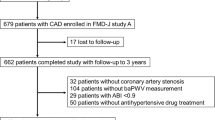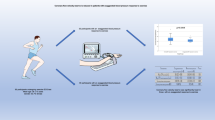Abstract
Retrograde flow in endothelial cell cultures has been shown to induce a pro-atherogenic phenotype. Despite its potential role as a pathophysiological link between cardiovascular risk factors and atherosclerotic disease, resting retrograde flows between patients with cardiovascular disease and healthy subjects have not been compared. Further, the vascular characteristics governing retrograde flow in human arteries have not been systematically investigated. Association of central and peripheral vascular characteristics with retrograde flow profile was investigated in 32 healthy subjects and 47 patients with ischemic heart disease. Endothelial dysfunction was assessed by brachial ultrasound-based calculation of flow-mediated dilation (FMD) and sub-clinical atherosclerosis was estimated from carotid-intima media thickness (CIMT). Retrograde blood flow velocity (RBFV) and shear rate were comparable between the two groups (RBFV 1.82(0.97–3.32) vs 1.78(1.24–2.65) cm/s p = 0.79). Augmentation index was a significant determinant of retrograde flow in both patients and healthy subjects. Carotid artery incremental elastic modulus was an independent determinant of retrograde flow patterns in healthy subjects while ejection fraction, cf/cr PWV ratio and forearm vascular conductance emerged as independent determinants in patients. Retrograde flow patterns were also associated with FMD (RBFV r = −0.43, p = 0.004) and CIMT (r = 0.30, p = 0.041) in patients. The results of the study suggest a difference in the determinants of retrograde flow in patients and healthy subjects, with central arterial stiffness being a major contributor in healthy subjects while interaction between central, peripheral, and cardio-arterial factors influence retrograde flow in patients with ischemic heart disease.
This is a preview of subscription content, access via your institution
Access options
Subscribe to this journal
Receive 12 digital issues and online access to articles
$119.00 per year
only $9.92 per issue
Buy this article
- Purchase on Springer Link
- Instant access to full article PDF
Prices may be subject to local taxes which are calculated during checkout




Similar content being viewed by others
Data availability
Data generated and analysed for the study is available from the corresponding author upon request.
References
Ziegler T, Bouzourène K, Harrison VJ, Brunner HR, Hayoz D. Influence of oscillatory and unidirectional flow environments on the expression of endothelin and nitric oxide synthase in cultured endothelial cells. Arterioscler Thromb Vasc Biol. 1998;18:686–92.
De Keulenaer GW, Chappell DC, Ishizaka N, Nerem RM, Alexander RW, Griendling KK. Oscillatory and steady laminar shear stress differentially affect human endothelial redox state: role of a superoxide-producing NADH oxidase. Circ Res. 1998;82:1094–101.
Chappell DC, Varner SE, Nerem RM, Medford RM, Alexander RW. Oscillatory shear stress stimulates adhesion molecule expression in cultured human endothelium. Circ Res. 1998;82:532–9.
Conway DE, Williams MR, Eskin SG, McIntire LV. Endothelial cell responses to atheroprone flow are driven by two separate flow components: low time-average shear stress and fluid flow reversal. Am J Physiol Heart Circ Physiol. 2010;298:H367–374.
Cunningham KS, Gotlieb AI. The role of shear stress in the pathogenesis of atherosclerosis. Lab Invest. 2005;85:9–23.
Yang JW, Cho KI, Kim JH, Kim SY, Kim CS, Choi SY, et al. Wall shear stress in hypertensive patients is associated with carotid vascular deformation assessed by speckle tracking strain imaging. Clin Hypertens. 2014;20:10
Anderson TJ, Uehata A, Gerhard MD, Meredith IT, Knab S, Delagrange D, et al. Close relation of endothelial function in the human coronary and peripheral circulations. J Am Coll Cardiol. 1995;26:1235–41.
Credeur DP, Dobrosielski DA, Arce-Esquivel AA, Welsch MA. Brachial artery retrograde flow increases with age: relationship to physical function. Eur J Appl Physiol. 2009;107:219–25.
Bretón-Romero R, Wang N, Palmisano J, Larson MG, Vasan RS, Mitchell GF, et al. Cross-sectional associations of flow reversal, vascular function, and arterial stiffness in the framingham heart study. Arterioscler Thromb Vasc Biol. 2016;36:2452–9.
Casey DP, Padilla J, Joyner MJ. α-adrenergic vasoconstriction contributes to the age-related increase in conduit artery retrograde and oscillatory shear. Hypertension 2012;60:1016–22.
Nwose E, Richards R. Whole blood viscosity extrapolation formula: Note on appropriateness of units. North Am J Med Sci. 2011;3:384–6.
Chen CH, Nevo E, Fetics B, Pak PH, Yin FC, Maughan WL, et al. Estimation of central aortic pressure waveform by mathematical transformation of radial tonometry pressure. Validation of generalized transfer function. Circulation. 1997;95:1827–36.
Winer N, Weber MA, Sowers JR. The effect of antihypertensive drugs on vascular compliance. Curr Sci Inc. 2001;3:297–304.
de Souza FR, Sales ARK, Dos Santos MR, Porello RA, da Fonseca GWP, Sayegh ALC, et al. Retrograde and oscillatory shear rate in young anabolic androgenic steroid users. Scand J Med Sci Sports. 2019;29:422–9.
Leimbach WN, Wallin BG, Victor RG, Aylward PE, Sundlöf G, Mark AL. Direct evidence from intraneural recordings for increased central sympathetic outflow in patients with heart failure. Circulation 1986;73:913–9.
Hashimoto J, Ito S. Pulse pressure amplification, arterial stiffness, and peripheral wave reflection determine pulsatile flow waveform of the femoral artery. Hypertension. 2010;56:926–33.
Badhwar S, Chandran DS, Jaryal AK, Narang R, Patel C, Deepak KK. Brachial artery “low-flow mediated constriction” is associated with myocardial perfusion defect severity and mediated by an altered flow pattern during occlusion. Pulse (Basel). 2021;9:99–108.
Funding
This study was supported by Indian Council of Medical Research Grant No. 3/1/2 (2)/CVD/2018-NCD-II.
Author information
Authors and Affiliations
Contributions
SB contributed to conception and design of the study, data acquisition, analysis, and interpretation, drafting and final approval of the submitted manuscript. DSC contributed to conception and design of the study, interpretation of data, revising and final approval of the submitted manuscript. AKJ contributed to conception and design of the study, revising and final approval of the submitted manuscript. RN contributed to conception and design of the study, revising the article, and final approval of the submitted manuscript. CP contributed to conception and design of the study, acquisition, analysis and interpretation of data, revising the article, and final approval of the submitted manuscript. KKP contributed to conception and design of the study, revising the article, and final approval of the submitted manuscript.
Corresponding author
Ethics declarations
Competing interests
The authors declare no competing interests.
Ethical approval
The study was approved by the All India Institute of Medical Sciences, New Delhi, Institute Ethics Committee for Post Graduate Research for Clinical Science, for research on human subjects (Ref No. IECPG/288/27.04.2016,RT-37/29.06.2016) and the investigations conformed to the Declaration of Helsinki.
Additional information
Publisher’s note Springer Nature remains neutral with regard to jurisdictional claims in published maps and institutional affiliations.
Supplementary information
Rights and permissions
Springer Nature or its licensor holds exclusive rights to this article under a publishing agreement with the author(s) or other rightsholder(s); author self-archiving of the accepted manuscript version of this article is solely governed by the terms of such publishing agreement and applicable law.
About this article
Cite this article
Badhwar, S., Chandran, D.S., Jaryal, A.K. et al. Differential role of central and peripheral arterial stiffness in determining brachial artery resting retrograde flow in patients with ischemic heart disease vs healthy subjects. J Hum Hypertens 37, 803–812 (2023). https://doi.org/10.1038/s41371-022-00762-1
Received:
Revised:
Accepted:
Published:
Issue Date:
DOI: https://doi.org/10.1038/s41371-022-00762-1



